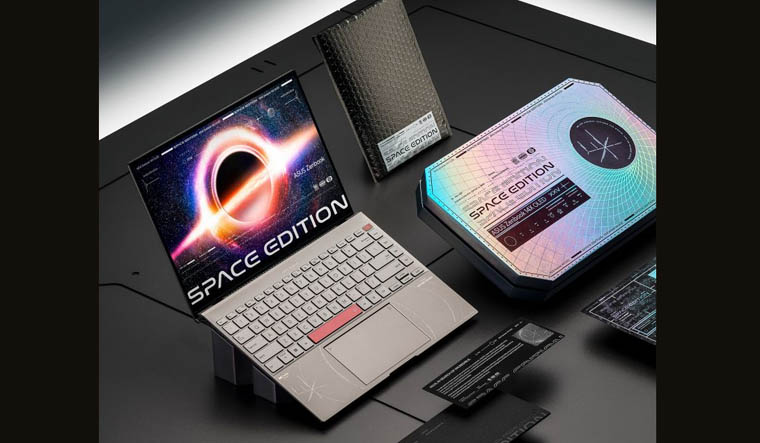Ultrabooks and design + performance often go hand in hand. But a lot of times, the design part can take a back seat or at times, performance can take a hit to offer the design part. With the ASUS Zenbook 14X OLED Space Edition (UX5401ZAS), ASUS tries to bridge the gap and provide a capable notebook that can be taken outside without compromising on the performance part.
In several bullet points, let’s try and check, what’s hit and what’s miss for this ultrabook:
• First things, the overall unboxing and early impressions of the device get thumbs up. Not only you get a nice separate box for the laptop, there’s also a nifty box for carrying around the power adapter, which doubles up as a laptop stand. Even the manual guide is packed in a shiny Velcro carry pouch.
• Design: One of the notebook’s little USPs is its 3.5-inch monochromatic LED on the lid. This little screen is only for showing you the time, battery left, and maybe some text or animation that you can customise from the MyASUS app. No notification or any other utility there. The overall design on the 14X Space Edition is just what you would expect from a special edition device, and it’s not just the titanium colour and morse code on the lid. There’s abstract space design on both the lids and near the palm-rest space. You get a slightly lower typing position for the keyboard and higher for the chassis thanks to the Ergolift hinge design from ASUS that you would notice as soon as you open the lid.
• There are two USB type C ports for charging, HDMI 2.0 (b) port on the left side; while the right side has the USB type A, 3.5mm audio jack, microSD card reader and the charging LED on the right side.
• Display: The notebook has a 14-inch OLED display with a resolution of 2880 x 1800 that supports HDR content. It supports 90Hz refresh rate and has a lower blue light emission, for which it’s TUV certified. The display is really sharp and has good rich black levels expected from an OLED, along with contrast and decent-ish brightness. The only disappointing thing about the display is its usage under direct sunlight and glossy finish since it’s a touchscreen. ASUS could have made it a little less prone to fingerprints and smudges. For high resolution videos and images, the display does a really good job handling multimedia stuff with its default calibration.
• Battery, keyboard and trackpad: The device packs a 63Wh battery and ships with a 100W charger (USB type C) with support for fast charging. The biggest downside of this laptop seems to be the battery backup, where it barely lasted 4-5 hours in one stretch. The laptop takes about 2 hours to charge from 5% to full. With brightness at around 30% and performance setting set to balance, often, the laptop had to be plugged in again in under 5 hours. The keyboard here is backlit with difference settings fro backlit though there’s no sensor for automatic backlit setting. Typing on the keyboard is fine, the give-in is quite decent, keys are responsive, don’t feel cheap at all and fit in well with the overall design and feel.
• Performance and OS: The notebook packs a 12th gen Intel i9 Core chip clocked at 2.5GHz with Intel Iris XE graphics card, 32GB LPDDR5 RAM and 1 TB SSD. There’s also a 16GB + 512GB model and lower u5 and i7 chip models, too. It runs on Windows 11 Home (21H2 version) out of the box. with a three pre-installed apps. Overall performance of the laptop is top notch. Playing games, on different modes watching high resolution videos, while having your Web browser opened and maybe some documents, the laptop was still not very noisy while handling these tasks well. Graphic-intensive games can also be played on this for which the GPU performance also seems up to the mark.



